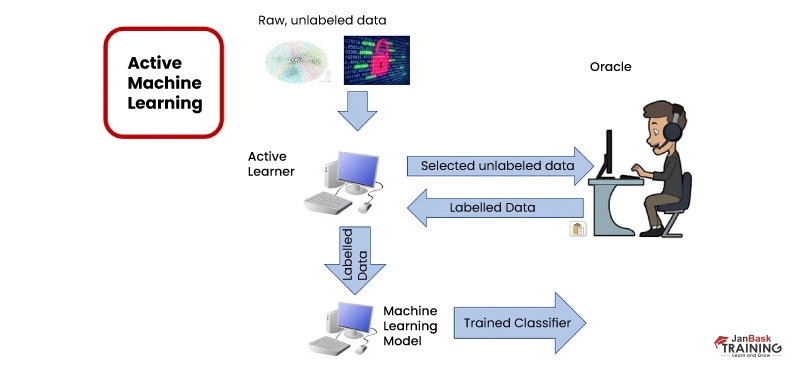Grab Deal : Upto 30% off on live classes + 2 free self-paced courses - SCHEDULE CALL
Active learning effectively enhances your data science skills by engaging in hands-on activities that promote critical thinking, problem-solving, and creativity. This blog post will explore active learning strategies and methods for data scientists to improve their knowledge and expertise. Active learning provides a more engaging approach than traditional passive learning methods such as lectures or reading textbooks. It involves hands-on activities that require learners to actively engage with the material through problem-solving, critical thinking, and creativity. Active learning has been shown to be effective in improving retention rates among students compared to traditional teaching methods. Let's dive more into the topic of active learning methods and learn more about their importance in data mining and key takeaways. You should check out the data science certification to clarify your basic concepts.

Active learning is a pedagogical approach that has gained popularity in recent years as it is believed to be more effective than traditional passive teaching methods. In an active learning environment, students are encouraged to take charge of their own learning by actively engaging with the material and participating in class discussions and activities.One example of active based learning in data science could involve using real-world datasets. Rather than simply reading about data analysis techniques or watching someone else perform them, students would have access to datasets that they can work on using various analytical tools like Python/R/SQL. This hands-on experience allows them to understand better how these tools work and how they can be applied in practice.Another important aspect of active learning is collaboration. Students are often paired up or grouped for projects or assignments, which helps promote teamwork skills while allowing for different perspectives and ideas to be shared. This type of collaborative learning prepares students for real-world scenarios where working with others is essential.
In addition, active learning promotes critical thinking skills by encouraging students to ask questions and solve problems through trial-and-error approaches rather than relying solely on memorisation or rote repetition. This approach fosters creativity and innovation and develops problem-solving skills that will serve them well throughout their careers.Active learning provides a more engaging and effective way for students to learn than traditional passive methods. By actively participating in their education, data science learners can gain valuable experience that will help prepare them for academic and professional future success.

Active learning is a teaching and learning approach that emphasizes the active participation of learners in their own education. It involves engaging students in activities requiring them to think, analyse, and apply knowledge actively. Data scientists can benefit from active learning strategies as it helps them stay up-to-date with the latest trends, technologies, and methodologies in data science.
Project-Based Approach: A project-based approach involves working on real-world projects where you apply your newly acquired skills to practice. This approach allows data scientists to learn by doing while providing opportunities for hands-on experience. For example, a data scientist may work on developing predictive models for an e-commerce company or analyzing customer behavior patterns for a retail organization.
Peer-to-Peer Collaboration: Collaborating with other data scientists can help you learn new techniques/tools while enhancing your communication/teamwork abilities. Peer collaboration allows sharing of knowledge and experiences with others with similar interests or expertise. It also allows individuals to receive feedback on their work which can lead to improvements in their skills.
Case Studies Analysis: Analyzing case studies provides insights into how different organizations have solved similar problems using different methodologies/approaches. Case studies provide practical examples of applying theoretical concepts in real-world situations. By studying successful case studies, data scientists can gain valuable insights into best practices within the industry.
Gamification Techniques: Using gamification techniques like quizzes, puzzles, and games can make learning more engaging and fun. Gamification uses game mechanics such as point systems or leaderboards to encourage learners' engagement and motivation towards completing tasks related to their field of study.Active learning strategies provide several benefits for data scientists seeking continuous professional development by keeping themselves updated with current trends and technologies within the industry while improving their analytical thinking/problem-solving capabilities through hands-on experience gained via collaborative peer interaction or project-based approaches combined with analysis of relevant case studies/games/quizzes/puzzles designed specifically for data scientists.
Active learning is a subset of machine learning that involves using algorithms to select the most informative data points for labeling by human experts. This process can save time and resources by reducing the amount of labeled data needed to train a model while still achieving high levels of accuracy.
In summary, Active Learning Methods have shown great potential in improving efficiency and accuracy in Machine Learning processes, especially when labelled data samples are limited.
There can be various benefits to using active learning in data mining. Here is the list of applications and benefits of active learning:

Data Science Training
Active learning is a powerful approach for data scientists looking to enhance their knowledge and expertise. By using active learning strategies and methods, active learners can engage in meaningful activities that promote critical thinking, problem-solving, and collaboration skills leading towards better retention of information. Whether working on projects or participating in hackathons/conferences/meetups, there are many ways to incorporate active learning into your daily routine. Understanding active learning in data mining begins with understanding data science; you can get an insight into the same through our data science training. So start exploring these options today and take your data science skills to the next level.

Basic Statistical Descriptions of Data in Data Mining



Rule-Based Classification in Data Mining

Cyber Security

QA

Salesforce

Business Analyst

MS SQL Server

Data Science

DevOps

Hadoop

Python

Artificial Intelligence

Machine Learning

Tableau
Download Syllabus
Get Complete Course Syllabus
Enroll For Demo Class
It will take less than a minute
Tutorials
Interviews
You must be logged in to post a comment